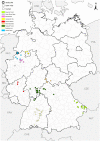Cluster of human Puumala orthohantavirus infections due to indoor exposure?-An interdisciplinary outbreak investigation
- PMID: 35312223
- PMCID: PMC9539979
- DOI: 10.1111/zph.12940
Cluster of human Puumala orthohantavirus infections due to indoor exposure?-An interdisciplinary outbreak investigation
Abstract
Puumala orthohantavirus (PUUV) is the most important hantavirus species in Europe, causing the majority of human hantavirus disease cases. In central and western Europe, the occurrence of human infections is mainly driven by bank vole population dynamics influenced by beech mast. In Germany, hantavirus epidemic years are observed in 2- to 5-year intervals. Many of the human infections are recorded in summer and early autumn, coinciding with peaks in bank vole populations. Here, we describe a molecular epidemiological investigation in a small company with eight employees of whom five contracted hantavirus infections in late 2017. Standardized interviews with employees were conducted to assess the circumstances under which the disease cluster occurred, how the employees were exposed and which counteractive measures were taken. Initially, two employees were admitted to hospital and serologically diagnosed with hantavirus infection. Subsequently, further investigations were conducted. By means of a self-administered questionnaire, three additional symptomatic cases could be identified. The hospital patients' sera were investigated and revealed in one patient a partial PUUV L segment sequence, which was identical to PUUV sequences from several bank voles collected in close proximity to company buildings. This investigation highlights the importance of a One Health approach that combines efforts from human and veterinary medicine, ecology and public health to reveal the origin of hantavirus disease clusters.
Keywords: Clethrionomys glareolus; Puumala orthohantavirus; One Health initiative; hantavirus outbreak; occupational exposure.
© 2022 The Authors. Zoonoses and Public Health published by Wiley-VCH GmbH.
Conflict of interest statement
The authors declare that no conflict of interest exists.
Figures


References
-
- Binder, F. , Drewes, S. , Imholt, C. , Saathoff, M. , Below, D. A. , Bendl, E. , Conraths, F. J. , Tenhaken, P. , Mylius, M. , Brockmann, S. , Oehme, R. , Freise, J. , Jacob, J. , & Ulrich, R. G. (2020). Heterogeneous Puumala orthohantavirus situation in endemic regions in Germany in summer 2019. Transboundary and Emerging Diseases, 67(2), 502–509. 10.1111/tbed.13408 - DOI - PubMed
-
- Brenner, B. , Endrich, A. , Pawlitzki, B. , Trani, M. , Tuschak, C. , Schneider, C. K. , Daniels, H. , Osterberg, A. , Eßbauer, S. , & Herr, C. (2012). Infektionsgefährdung durch Hantavirus und Leptospiren beim Styroporrecycling. Arbeitsmedizin, Sozialmedizin, Umweltmedizin, 47(8), 441.
Publication types
MeSH terms
LinkOut - more resources
Full Text Sources
Medical

